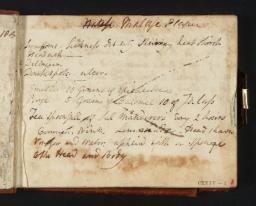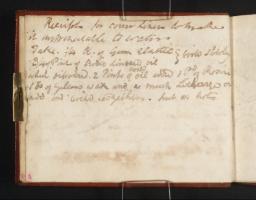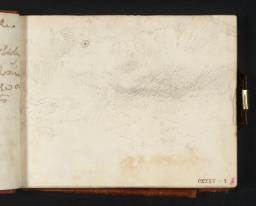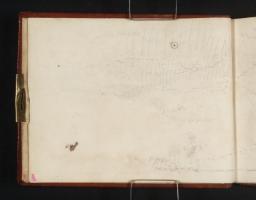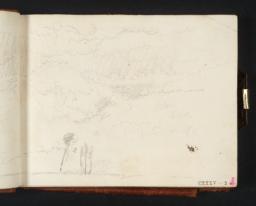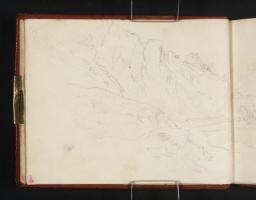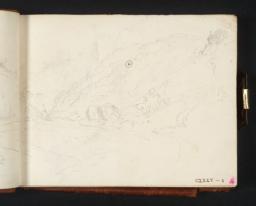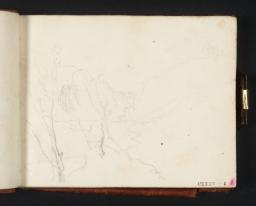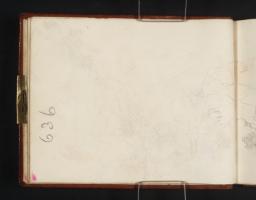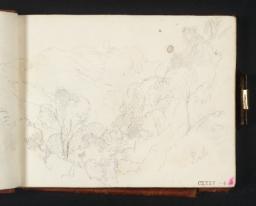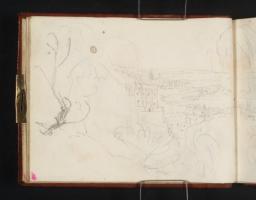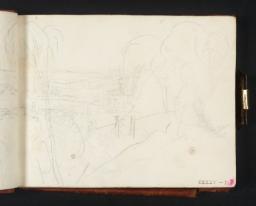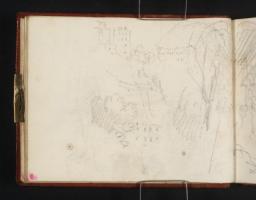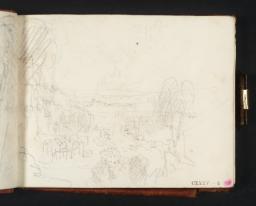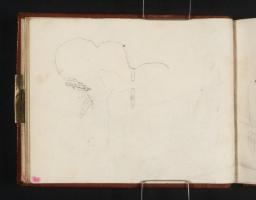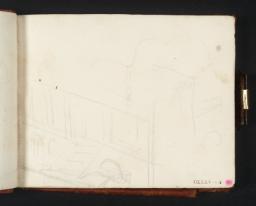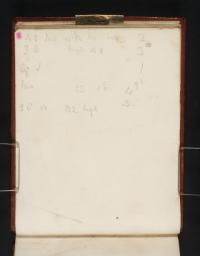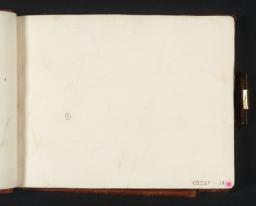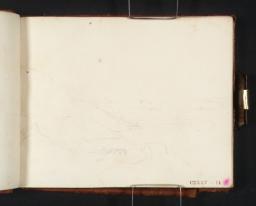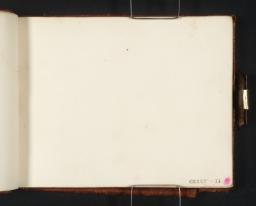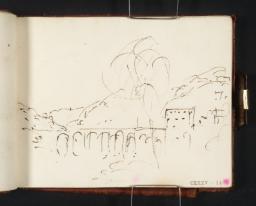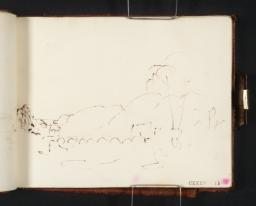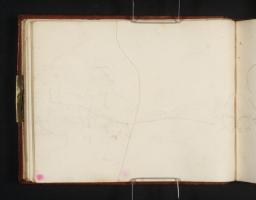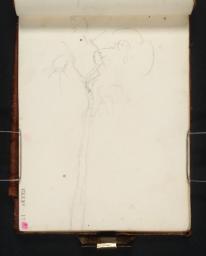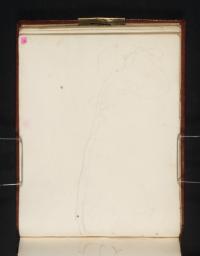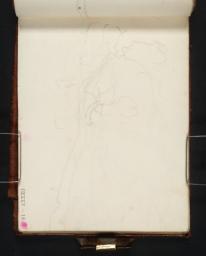Turner Bequest CXXXV 1–68a
Sketchbook bound in boards, covered in reddish-brown leather with blind-stamped decorative borders and brass clasps; leather pencil loop along bottom edge of back cover
68 leaves and pastedowns of white wove paper; page size 88 x 113 mm
The paper made by Charles Wilmott, Sundridge Mill, Kent, and watermarked ‘C Wilmott | 1811’
Inscribed by Turner ‘60’ on label (now lost, but presumably once glued to the spine)
Numbered 371 as part of the Turner Schedule in 1854 and endorsed by the Executors of the Turner Bequest, inside front cover (D41524)
Blind-stamped with Turner Bequest monogram top left of front cover
John Ruskin’s endorsement, ‘371. Chemistry and Studies of picture for Claude Bridge’, recorded by Finberg
68 leaves and pastedowns of white wove paper; page size 88 x 113 mm
The paper made by Charles Wilmott, Sundridge Mill, Kent, and watermarked ‘C Wilmott | 1811’
Inscribed by Turner ‘60’ on label (now lost, but presumably once glued to the spine)
Numbered 371 as part of the Turner Schedule in 1854 and endorsed by the Executors of the Turner Bequest, inside front cover (D41524)
Blind-stamped with Turner Bequest monogram top left of front cover
John Ruskin’s endorsement, ‘371. Chemistry and Studies of picture for Claude Bridge’, recorded by Finberg
Accepted by the nation as part of the Turner Bequest 1856
References
Finberg’s title for this sketchbook combines two aspects of its miscellaneous contents: studies relating to Turner’s large painting Apullia [sic] in Search of Appullus (Tate N00495),1 exhibited in 1814, and notes on chemical reactions and resultant colours. The main topographical sequence runs from folio 3 verso to folio 8 recto (D09894–D09902), comprising views around the Avon Gorge outside Bristol. Turner’s most significant visit to the Bristol had been in 1791 when he stayed with family friends, and there are a few scattered studies from later in the 1790s (see under folio 3 verso; D09894). No subsequent visit has previously been recorded, although another Bristol subject is the unfinished painting showing A View on Avon (private collection), which has been dated to about 1825 stylistically, and after 1822 on topographical grounds;2 this shows the view down the Avon Gorge from the south, whereas the sketches here look in the opposite direction or across it.
Some leaves of this sketchbook are watermarked 1811 but, given that Turner did not pass as far north as Bristol on the return leg of his major tour of the West Country that year (see the relevant section of the present catalogue), it seems probable that he made these studies en route to or from Devon on his second visit, in 1813 (see the Introduction to the present tour). Other drawings and at least some of the inscriptions in this sketchbook are also likely to date from that year. As discussed in the Introduction to the tour, Sam Smiles has proposed a further Devon visit in 1814, but the various sketches relating to Apullia in Search of Appullus (assuming they are working studies for it) must date from 1813 at the latest, as the painting was submitted to the British Institution in London on 15 January 1814,3 and Finberg’s dating of about 1813 has been retained throughout.
Apullia is discussed further under folio 63 verso (D09976). Other studies relate to a second significant painting, Crossing the Brook, exhibited in 1815 (Tate N00497),4 like Apullia a classical, Claude Lorrain-inspired composition, but in this instance focusing on a real view down the Tamar Valley at the boundaries of Devon and Cornwall, for which there are precise topographical studies elsewhere in the Turner Bequest. See under folio 14 recto (D09910) for more on the setting of the picture, and a checklist of sketches which can be related to it and Apullia. Thornbury described some of them: ‘smeared by rubbing, the lines are blunt, soft pencil lines; the trees often loop, and some of the boughs are mere lank fingers and dark zigzags. Yet even in these there is an implication of Turner’s great qualities of multitude and distance.’5
As for the ‘Chemistry’, there are extensive notes on varnishes and colours. Without establishing their published origin, Joyce Townsend has transcribed and made a detailed analysis of them along with other such material.6 Their source is identifiable as the extensively revised edition of William Nicholson’s Dictionary of Practical and Theoretical Chemistry, with its Application to the Arts and Manufactures, and to the Explanation of the Phænomena of Nature (London 1808), first published in a different format in 1795.7 No copy is listed in Turner’s personal library,8 so he presumably consulted it elsewhere, perhaps at the British Museum (the copy is now held at the British Library, London), where he had earlier studied perspective treatises – see in particular the Perspective sketchbook of about 1809 (Tate; Turner Bequest CVIII).
As Turner did not transcribe the headings of Nicholson’s dictionary entries, Townsend naturally assumed the processes and materials described comprised legitimate (if unusual) artists’ colourmen’s recipes for preparing pigments,9 whereas in fact Turner appears simply to have skimmed his way through the text, alighting now and again on promising descriptions of colours resulting from chemical reactions. He seems to have started with Nicholson’s entry on varnish, with supplementary notes from the entry on copal, and then worked alphabetically through the rest of the dictionary before finally making notes on acids. The notes are inverted in relation to the present foliation, he was presumably working inwards from the back cover. The note on the page preceding this reversed sequence (folio 55 recto; D09959) has not been traced to Nicholson, nor has the subsequent chart or diagram relating to varnishes on folio 62 verso (D09974). The relevant folios of Turner’s notes in between and the headings of corresponding unpaginated entries in Nicholson are as follows:
| Folio | Tate | Nicholson heading |
| 62 Recto | D09973 | Copal |
| 61 Verso | D09972 | Varnish, Copal |
| 61 Recto | D09971 | Varnish |
| 60 Verso | D09970 | Varnish |
| 59 Verso | D09968 | Iron |
| 58 Verso | D09966 | Lac, Lead, Naples Yellow |
| 58 Recto | D09965 | Panacea, Peru (Balsam of) |
| 57 Verso | D09964 | Peruvian Bark |
| 57 Recto | D09963 | Pottery, Potash, Roucou |
| 56 Verso | D09962 | Saffron (Bastard), Soap |
| 56 Recto | D09961 | Soap, Weld |
| 55 Verso | D09960 | Acid (Molybdenous), Acid (Molybdenic) |
There are various other notes, including a treatment for ‘Maltese Plague’ on folio 1 recto (D09889), prompted by an 1813 outbreak on the island, and a waterproofing treatment, probably from a trade magazine of that year, on the verso (D09890). Lists of banknotes inside the front cover (D41524) and on folio 67 recto (D09983) also include the date. Elsewhere there are notes on print sales (folio 54 verso; D09958) and an isolated draft of Turner’s own poetry (folio 27 verso; D09930).
The sketchbook is one of those which Thornbury inspected closely at an early date with John Ruskin’s assistance.10 As well as discussing the landscape sketches (see above), he described and partially transcribed many of Turner’s notes, as set out in the individual entries here. He found Turner’s extensive references to yellows in the chemistry passages ‘very noteworthy’.11 Sam Smiles has also observed the opposition of blues and yellows in Turner’s 1813 Devon oil sketches (see the Introduction to the tour) in relation to these presumably contemporary notes on yellows.12
Martin Butlin and Evelyn Joll, The Paintings of J.M.W. Turner, revised ed., New Haven and London 1984, pp.91–2 no.128, pl.134.
Andrew Wilton, Turner in his Time, London 1987, pp.246–7; compare list in D[ugald] S. MacColl, ‘Notes on English Art II – Turner’s Lectures at the Academy’, Burlington Magazine, vol.12, March 1908, p.345 note 7.
See Townsend 1992, p.8; see also Townsend 1990, p.15; for further speculation on Turner’s sources and motivations see Gage 1969, p.226 note 13, Hamilton 1998, pp.10, 52, and Hamilton 2001, p.280.
Technical notes
How to cite
Matthew Imms, ‘Chemistry and Apuleia Sketchbook c.1813’, sketchbook, April 2014, in David Blayney Brown (ed.), J.M.W. Turner: Sketchbooks, Drawings and Watercolours, Tate Research Publication, September 2014, https://www

